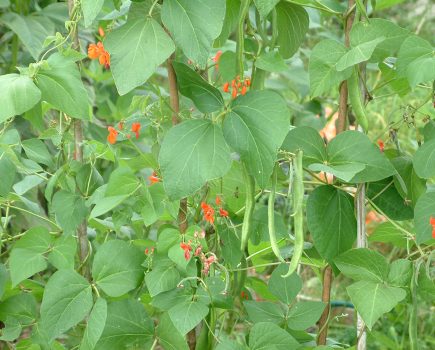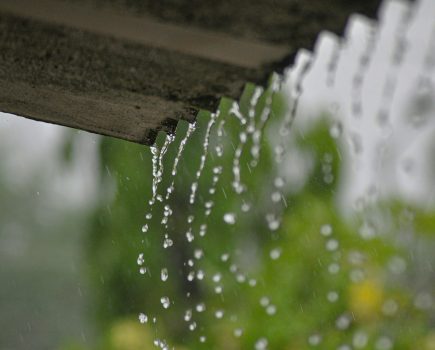Welsh allotmenteer Terry Walton has become an unlikely star on The Jeremy Vine Show on BBC Radio 2. In the last part of a three-part series, he dispenses more growing wisdom to STEVE CHILCOTT
So what about blight,Terry?
You just pick it off when you spot it. You can’t stop it. I never get it on tomatoes – touch wood! Tomatoes in the greenhouse, potatoes in the open soil. I don’t spray for blight. As soon as I get it I take the foliage off and lift them. You get a reduced crop, that’s all. Again you don’t expect blight on earlies and second crop, which I grow mainly. Main crop comes in August.But I found the solution a few years ago: a Hungarian potato called Sarpo (1); 100% blight-free, I guarantee it! Sarpo has been cross-pollinated; they’ve taken the characteristic of some native plant and crossed it with tubers to get potatoes that are immune.I grow Pentland Javelin as earlies, Kestrel as second crop, some Cara as main crop and Sarpo…Are you telling me that if you have a row there that has got blight, and next to it you’ve got Sarpo, the Sarpo won’t get blight?Yes! Absolutely!I paid £20 for 40 tubers; 50p per tuber from Thompson & Morgan, which nearly broke my heart! They sent me five large sacks. I thought if I fill those sacks at least I’ve got my money back! I kept my stock, but last year I lost them in the winter; they sprouted and were no good by the time I wanted to plant them. So I didn’t grow them last year, and that was the worst year on record for blight for a long, long time. Main crop was decimated, so I looked around this year; they were more freely available and I bought some. I’m back on the Sarpo trail again!The only reason you grow maincrop is you get a much bigger crop, and if you can keep them free of blight you can store them for the winter. You won’t get the same density of crop off an early potato, but you’ll save money.People always say you can’t dig them if they haven’t flowered. But a potato regenerates by two means: increasing the number of tubers in the soil, and by the flower pollinating and making potato apples which are full of seed. Now to grow potato fully from seed takes anything up to five years, and that’s how they generate new varieties, by cross-pollinating the seed.Digging potatoes is like unearthing buried treasure, and you never know what you are going to find once you start. But no matter how thorough you are, you can’t get them all out in one go. You may think you’ve cleared them, and then you put the fork back in, shake the soil about and you find four or five more, often bigger ones that were missing first time round.Blight on tomatoes is all down to ventilation. Keep the ventilation going and you’ve a fair chance of not getting it.The tomatoes I grow are Shirley as main and Gardeners Delight as cherry. They go on forever and I’m still picking tomatoes in the middle of December.I grow cucumbers – all-female variety – and peppers, in large buckets with no bottoms because everything in my greenhouse is grown in the border.The ends of the roots go into the earth. Drainage is good and I grow them up over the trellis at the top.This stops the black stem rot which is fatal to cucumbers if they are sitting too low in water. Most of the root is in the ground but the stem is way above. I empty the borders every two years and put liberal dressings of manure and fresh soil and compost.Do you use green manure crops?Definitely! I took up green manuring five years ago. I went to a lecture; I didn’t know much about green manure prior to that. I used to do the old-fashioned ‘winter digging’, but that releases goodness when it is wet. I learnt all about these Lifters and Fixers (2) and I’m a great advocate of this now. What do you use?Westerwold Rye. It’s brilliant but you mustn’t let it grow too tall or go to seed. I used to plant it in the second or third week in August but it grows too quickly. Now I sow it in the second week in September and it makes decent growth to hold everything in winter. In late January/early February I dig it in again. Like this it won’t go to seed.At what rate?I just scatter it! In early February you dig it back in.It is difficult to control the length but I just open a trench and throw in and cover, throw in and cover… it needs at least five weeks of rotting and that breaks down to a fantastic material. If you dig in February you can be planting again by April. Vetches and clover are nitrogen-producing but they need two years really before they peak. That’s all right if you’ve got space to leave a fallow. Mustard’s a problem if you get a cold snap; frost will kill it off very quickly. Westerwold is ideal!You need the ground covered through the wet autumns and into the New Year when hopefully it will go drier but colder.Do you use raised beds at all?No…waste of space! You can’t eat what grows on the paths, and you’ve got so many paths! It’s all right if you’ve got a handicap or disability of some kind, but I’ve got one path. Down that side and down that side and that’s the only path on the plot.Doesn’t that compact the soil?The minute you walk on it you break it up again with the hoe. You keep the hoe on the go all the time. You won’t see a footprint on my plot!The late Lawrence D Hills, who founded the Henry Doubleday Research Association up at Ryton Gardens – a great hero of mine, swore by Russian comfrey as a fertiliser. He would cut it and leave it to rot in the trenches between the potato rows. I don’t use comfrey. I use either nettles or rhubarb leaves, which have the same effect. Rhubarb leaves are poisonous if you eat them, but they are OK once they have been fermented.Clarissa Dickson Wright – she’s a hell of a girl! – she told me this one:“…to water cabbages and other brassicas, both to keep the cabbage white butterfly away and as a bonus to provide some kind of feed … I have an old black plastic dustbin which I three-quarters fill with water. As I harvest rhubarb stems I trim off the leaves and add them to the water, giving them a good stir before replacing the lid. I keep adding more, stirring twice weekly, until after a few weeks the soup begins to smell slightly evil: a sure sign that it’s ready … It doesn’t stop white fly, as this tends to collect on the underside of leaves, nor will it control mealy bug, which forms in some less accessible places on the leaves. But no single method controls everything.”Nettles are a superb addition to a compost heap. Nettles before they flower! They have some magical ingredient when they go back into the soil, particularly in potato ground.If people have got beds of nettles I say put them in a bag and give them to me!What about companion planting?I don’t believe in it … No, let me re-phrase that! I use companion planting in the greenhouse very effectively where I grow marigolds with my tomatoes, cucumbers and peppers, and in that combined space you can smell the marigolds very strongly and it does deter the whitefly, but, in the open space, with the breezes and everything, it doesn’t work very well. The insects are so adapted to identify the host plant that, despite the garlic and the onions, they will still find a carrot. I’m sure these flies that you can’t see have got magnificent snouts!I use barriers and that’s very effective. Physical barriers like fleece. I grow carrots in bins at least 4ft off the ground. The carrot fly suffers from vertigo and can only fly at a maximum of 21 inches; above that it gets dizzy and falls to the ground!
Addenda.1). Thompson & Morgan have promoted this new variety enthusiastically since its inception in 2005. Bred originally by the Sarvari family in Hungary in conjunction with University Farm Wales in Bangor, Sarpo Mira (SARvari POtato) claims high yield, luxuriant weed-suppressant foliage and almost 100% immunity to the old enemy blight. In addition slugs and wireworm don’t care for it much either. Sarpo Axona is now available as Soil Association accredited seed. (2) Nitrogen lifters scavenge excess nitrogen left by previous crops in the soil, some up to 90%, preventing it from leaching away, and release this back to the following crop when they are dug and decompose. Some leguminous plants are fixers, gathering free nitrogen from the air and trapping this in nodules on their root system.Catch Terry Walton every other Friday on the Jeremy Vine Show on BBC Radio 2 (check their website for full details).Terry’s delightful book My Life on a Hillside Allotment is published in both hardback and in paperback by Transworld Publishers/Bantam Press at £12.99 and £9.99 respectively. It is available through the CS Bookshop.Feedback please to steve@thecountrysmallholder.com







